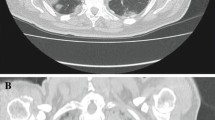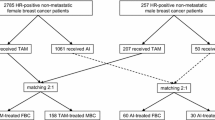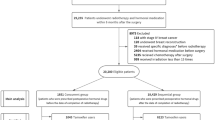Abstract
Purpose
The purpose of this study is to compare the effects of anastrozole, letrozole and tamoxifen on radiation-induced pulmonary fibrosis.
Methods
Eighty female Wistar albino rats were divided into eight groups. Group (G) 1 was defined as control group. G2 was radiation therapy (RT) only group. Groups 3, 4 and 5 were tamoxifen, anastrozole and letrozole control groups respectively. Groups 6, 7 and 8 were RT plus tamoxifen, anastrozole and letrozole groups, respectively. A single dose of 12 Gy RT was given to both lungs. Tamoxifen, anastrozole and letrozole were started 1 week before the RT and continued until the animals were sacrificed 16 weeks after the RT. As an end point, the extent of pulmonary fibrosis for each rat was quantified with image analysis of histological sections of the lung. Kruskal–Wallis and Mann–Whitney U tests were used for statistical analyses.
Results
The congestion, inflammation and pulmonary fibrosis scores were significantly different between all the study groups (p values were <0.001 for each). When compared with RT only group, concomitant RT and tamoxifen group increased the radiation-induced pulmonary fibrosis (p = 0.005). However, using either anastrozole or letrozole with RT did not increase the radiation-induced pulmonary fibrosis (p values were 0.768 and 0.752, respectively).
Conclusion
Concomitant use of tamoxifen with RT seems to increase radiation-induced pulmonary toxicity. However, the use of both anastrozole and letrozole appears to be safe with concomitant RT, without increasing the risk of pulmonary fibrosis. This finding should be clarified with further clinical studies.


Similar content being viewed by others
References
Graves PR, Siddiqui F, Anscher MS, Movsas B (2010) Radiation pulmonary toxicity: from mechanisms to management. Semin Radiat Oncol 20:201–207
Kocak Z, Evans ES, Zhou SM (2005) Challenges in defining radiation pneumonitis in patients with lung cancer. Int J Radiat Oncol Biol Phys 62:635–638
Trott KR, Herrmann T, Kasper M (2004) Target cells in radiation pneumopathy. Int J Radiat Oncol Biol Phys 58(2):463–469
Kasper M, Haroske G (1996) Alterations in the alveolar epithelium after injury leading to pulmonary fibrosis. Histol Histopathol 11:463–483
Fleckenstein K, Zgonjanin L, Chen L (2007) Temporal onset of hypoxia and oxidative stress after pulmonary irradiation. Int J Radiat Oncol Biol Phys 68:196–204
Chen Y, Williams J, Ding I et al (2002) Radiation pneumonitis and early circulatory cytokine markers. Semin Radiat Oncol 12:26–33
Jordan VC (2004) Selective estrogen receptor modulation: concept and consequences in cancer. Cancer Cell 5:207–213
Bese NS, Umay C, Yildirim S, Ilvan S, Dirican A, Salar S et al (2006) The effects of tamoxifen on radiation-induced pulmonary fibrosis in Wistar albino rats: results of an experimental study. Breast 15:456–460
Koc M, Polat P, Suma S (2002) Effects of tamoxifen on pulmonary fibrosis after cobalt-60 radiotherapy in breast cancer patients. Radiother Oncol 64:171–175
Huang E-Y, Wang C-J, Chen H-C et al (2000) Multivariate analysis of pulmonary fibrosis after electron beam irradiation for postmastectomy chest wall and regional lypmhatics: evidence for non-dosimetric factors. Radiother Oncol 57:91–96
Bentzen SM, Skoczylas JZ, Overgaard M, Overgaard J (1996) Radiotherapy-related lung fibrosis enhanced by tamoxifen. J Natl Cancer Inst 88:918–922
Ashcroft T, Simpson JM, Timbrelli V (1988) Simple method of estimating severity of pulmonary fibrosis on a numerical scale. J Clin Pathol 41:467–470
Osborne C, Boldt D, Clark G et al (1983) Effects of tamoxifen on human breast cancer cell cycle kinetics: accumulation of cells in early G1 phase. Cancer Res 43:3583–3585
Wazer D, Tercilla O, Lin P et al (1989) Modulation in the radiosensitivity of MCF-7 human breast carcinoma cells by 17-estradiol and tamoxifen. Br J Radiol 62:1079–1083
Paulsen G, Strickert T, Marthinsen A et al (1996) Changes in radiation sensitivity and steroid receptor content induced by hormonal agents and ionizing radiation in breast cancer cells in vitro. Acta Oncol 35:1011–1019
Sarkaria J, Miller E, Parker C et al (1994) 4-Hydroxytamoxifen, an active metabolite of tamoxifen, does not alter the radiation sensitivity of MCF-7 breast carcinoma cells irradiated in vitro. Breast Cancer Res Treat 30:159–165
Ellis P, Saccani-Jotti G, Clarke R et al (1997) Introduction of apoptosis by tamoxifen and ICI 182780 in primary breast cancer. Int J Cancer 72:608–613
Whelan T, Levine M (2005) Radiation therapy and tamoxifen: concurrent or sequential? That is the question. J Clin Oncol 23(1):1–4
Azria D, Larbouret C, Cunat S et al (2005) Letrozole sensitizes breast cancer cells to ionizing radiation. Breast Cancer Res 7(1):R156–R163
Brenner DJ (2008) The linear-quadratic model is an appropriate methodology for determining isoeffective doses at large doses per fraction. Semin Radiat Oncol 18(4):234–239
Baum M, Buzdar A, Cuzick J et al (2003) Anastrozole alone or in combination with tamoxifen versus tamoxifen alone for adjuvant treatment of postmenopausal women with early-stage breast cancer: results of the ATAC (Arimidex, Tamoxifen Alone or in Combination) trial efficacy and safety update analyses. Cancer 98:1802–1810
Howell A, Cuzick J, Baum M et al (2005) Results of the ATAC (Arimidex, Tamoxifen, Alone or in Combination) trial after completion of 5 years’ adjuvant treatment for breast cancer. Lancet 365:60–62
Forbes JF, Cuzick J, Buzdar A et al (2008) Effect of anastrozole and tamoxifen as adjuvant treatment for early-stage breast cancer: 100-month analysis of the ATAC trial. Lancet Oncol 9:45–53
Buzdar A, Howell A, Cuzick J et al (2006) Comprehensive side-effect profile of anastrozole and tamoxifen as adjuvant treatment for early-stage breast cancer: long-term safety analysis of the ATAC trial. Lancet Oncol 7:633–643
Cuzick J, Sestak I, Baum M, Buzdar A, Howell A, Dowsett M, Forbes JF, ATAC/LATTE investigators (2010) Effect of anastrozole and tamoxifen as adjuvant treatment for early-stage breast cancer: 10-year analysis of the ATAC trial. Lancet Oncol 11(12):1135–1141
ATAC Trialists’ Group (2002) Anastrozole alone or in combination with tamoxifen versus tamoxifen alone for adjuvant treatment of postmenopausal women with early breast cancer: first results of the ATAC randomized trial. Lancet 359:2131–2139
Coombes RC, Hall E, Gibson LJ, Paridaens R, Jassem J et al (2004) A randomized trial of exemestane after two to three years of tamoxifen therapy in postmenopausal women with primary breast cancer. N Engl J Med 350:1081–1092
Goss PE, Hadji P, Subar M, Abreu P, Thomsen T, Banke-Bochita J (2007) Effects of steroidal and non-steroidal aromatase inhibitors on markers of bone turnover in healthy postmenopausal women. Breast Cancer Res 9(4):R52
Love RR, Barden HS, Mazess RB, Epstein S, Chappell RJ (1994) Effect of tamoxifen on lumbar spine bone mineral density in postmenopausal women after 5 years. Arch Intern Med 154:2585–2588
Bese NS, Umay C, Serdengecti S, Kepil N, Sut N, Altug T, Ober A (2010) The impact of trastuzumab on radiation-induced pulmonary fibrosis: results of an experimental study. Med Oncol 27(4):1415–1419
Acknowledgments
Funding source
This work is supported by Selcuk University, Selcuklu Faculty of Medicine (SUSFM 12401036). There is no role of study sponsors in the study design, in the collection, analysis and interpretation of data; in the writing of the manuscript and in the decision to submit the manuscript for publication.
Conflict of interest
The authors declare that they have no conflict of interest.
Author information
Authors and Affiliations
Corresponding author
Rights and permissions
About this article
Cite this article
Yavas, G., Yavas, C., Acar, H. et al. Comparison of the effects of aromatase inhibitors and tamoxifen on radiation-induced lung toxicity: results of an experimental study. Support Care Cancer 21, 811–817 (2013). https://doi.org/10.1007/s00520-012-1584-7
Received:
Accepted:
Published:
Issue Date:
DOI: https://doi.org/10.1007/s00520-012-1584-7




